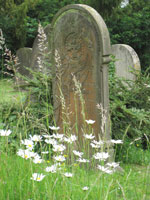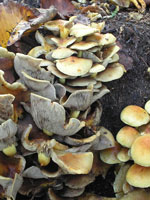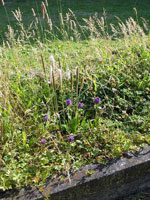Wildflowers and Insects
Some areas of grass are left to grow and seed during the summer. We hope these undisturbed areas provide a haven for insects and small mammals.
Other areas have been scarified and sown with a meadow mixture of seed containing over thirty species such as yarrow, common knapweed, cowslip and betony, most of which should thrive on our clay soil. Yellow rattle seed was added to the mix because this plant parasitizes grass, weakening the sward so that the wildflowers can establish themselves.
When we remove the ropes so the Council can cut the grass, we rake away the hay so that gradually the soil fertility is reduced, which again gives the wildflowers a better chance against the grass.
Grave plots provide a variety of micro-habitats for plants and wildlife so some of these have been left undisturbed. The tops of a small number of kerbed graves have been lined with tough plastic sheet and then the soil or stone chippings replaced. By trapping rainwater we hope to create damper areas to provide moisture for wildlife.
In a couple of places along the southern boundary, we have built “dry hedges” with the help of local community groups such as the Guides. These wooden frames filled with bundles of twigs form large “insect hotels” for the benefit of invertebrates. We have also planted “whips” and saplings of native hedging plants along here, such as hawthorn, blackthorn and hazel, to offer better wildlife habitat – and look beautiful!



